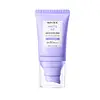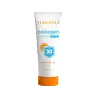What's inside
What's inside
 Key Ingredients
Key Ingredients

 Benefits
Benefits

 Concerns
Concerns

 Ingredients Side-by-side
Ingredients Side-by-side

Water
Skin ConditioningEthylhexyl Methoxycinnamate
UV AbsorberDiethylamino Hydroxybenzoyl Hexyl Benzoate
UV FilterButylene Glycol
HumectantMethyl Methacrylate Crosspolymer
Ethylhexyl Triazone
UV AbsorberBis-Ethylhexyloxyphenol Methoxyphenyl Triazine
Skin ConditioningGlycereth-26
HumectantEthylhexyl Palmitate
EmollientIsononyl Isononanoate
EmollientDimethicone
EmollientFomes Officinalis Extract
Skin ProtectingCetyl Alcohol
EmollientGlyceryl Stearate
Emollient1,2-Hexanediol
Skin ConditioningSorbitan Oleate
EmulsifyingSilica
AbrasiveHydroxyacetophenone
AntioxidantSodium Polyacrylate
AbsorbentPEG-75 Stearate
Acrylates/C10-30 Alkyl Acrylate Crosspolymer
Emulsion StabilisingPotassium Cetyl Phosphate
EmulsifyingTocopheryl Acetate
AntioxidantCeteth-20
CleansingSteareth-20
CleansingEctoin
Skin ConditioningAvena Sativa Kernel Extract
AbrasiveZinc PCA
HumectantSodium Hydroxide
BufferingXanthan Gum
EmulsifyingGentiana Scabra Root Extract
Skin ConditioningPhenoxyethanol
PreservativeDisodium EDTA
Tocopherol
AntioxidantPEG-40 Hydrogenated Castor Oil
EmulsifyingBHT
AntioxidantPentylene Glycol
Skin ConditioningWater, Ethylhexyl Methoxycinnamate, Diethylamino Hydroxybenzoyl Hexyl Benzoate, Butylene Glycol, Methyl Methacrylate Crosspolymer, Ethylhexyl Triazone, Bis-Ethylhexyloxyphenol Methoxyphenyl Triazine, Glycereth-26, Ethylhexyl Palmitate, Isononyl Isononanoate, Dimethicone, Fomes Officinalis Extract, Cetyl Alcohol, Glyceryl Stearate, 1,2-Hexanediol, Sorbitan Oleate, Silica, Hydroxyacetophenone, Sodium Polyacrylate, PEG-75 Stearate, Acrylates/C10-30 Alkyl Acrylate Crosspolymer, Potassium Cetyl Phosphate, Tocopheryl Acetate, Ceteth-20, Steareth-20, Ectoin, Avena Sativa Kernel Extract, Zinc PCA, Sodium Hydroxide, Xanthan Gum, Gentiana Scabra Root Extract, Phenoxyethanol, Disodium EDTA, Tocopherol, PEG-40 Hydrogenated Castor Oil, BHT, Pentylene Glycol
Water
Skin ConditioningEthylhexyl Methoxycinnamate
UV AbsorberDiethylamino Hydroxybenzoyl Hexyl Benzoate
UV FilterNeopentyl Glycol Diheptanoate
EmollientButylene Glycol
HumectantEthylhexyl Triazone
UV AbsorberTris-Biphenyl Triazine
UV AbsorberButyl Methoxydibenzoylmethane
UV AbsorberNiacinamide
SmoothingBis-Ethylhexyloxyphenol Methoxyphenyl Triazine
Skin ConditioningButyloctyl Salicylate
Skin ConditioningInositol
HumectantOctocrylene
UV AbsorberGlycine Soja Oil
EmollientPhenoxyethanol
PreservativePolyester-7
Skin ConditioningAcrylates/C10-30 Alkyl Acrylate Crosspolymer
Emulsion StabilisingDecyl Glucoside
CleansingCarbomer
Emulsion StabilisingDisodium EDTA
Polyglyceryl-3 Diisostearate
EmulsifyingSodium Polyacrylate
AbsorbentHydrogenated Polydecene
EmollientLactobacillus/Collagen Ferment Filtrate
HumectantLecithin
EmollientOryza Sativa Germ Extract
EmollientSodium Hydroxide
BufferingTocopheryl Acetate
AntioxidantTriethylene Glycol
MaskingDisodium Phosphate
BufferingTrideceth-6
EmulsifyingXanthan Gum
EmulsifyingArtemisia Vulgaris Extract
Skin ConditioningWater, Ethylhexyl Methoxycinnamate, Diethylamino Hydroxybenzoyl Hexyl Benzoate, Neopentyl Glycol Diheptanoate, Butylene Glycol, Ethylhexyl Triazone, Tris-Biphenyl Triazine, Butyl Methoxydibenzoylmethane, Niacinamide, Bis-Ethylhexyloxyphenol Methoxyphenyl Triazine, Butyloctyl Salicylate, Inositol, Octocrylene, Glycine Soja Oil, Phenoxyethanol, Polyester-7, Acrylates/C10-30 Alkyl Acrylate Crosspolymer, Decyl Glucoside, Carbomer, Disodium EDTA, Polyglyceryl-3 Diisostearate, Sodium Polyacrylate, Hydrogenated Polydecene, Lactobacillus/Collagen Ferment Filtrate, Lecithin, Oryza Sativa Germ Extract, Sodium Hydroxide, Tocopheryl Acetate, Triethylene Glycol, Disodium Phosphate, Trideceth-6, Xanthan Gum, Artemisia Vulgaris Extract
Ingredients Explained
These ingredients are found in both products.
Ingredients higher up in an ingredient list are typically present in a larger amount.
Acrylates/C10-30 Alkyl Acrylate Crosspolymer is a synthetic polymer. It is used to thicken and improve the texture of products. Due to its properties, it can prevent water and oil ingredients from separating.
You might know this ingredient as Tinosorb S or Bemotrizinol. It is a UV filter that covers both UVA and UVB rays.
This ingredient has two peak UV absorption peaks ( 310 and 340 nm) and is able to absorb both UV-A and UV-B rays. This ingredient works by preventing UV rays from reaching and damaging your skin.
On top of that - it is highly photostable and helps prevent the photodegration of other sunscreen ingredients such as avobenzone.
Tinosorb S is allowed in the EU, Australia, and Asia. It is close to being approved by the FDA and we'll hopefully get this ingredient in the U.S. by late 2025.
Fun fact: Tinosorb S is the most effective UV absorber at maximum concentration (measured by SPF) permitted in the EU.
This ingredient is oil-soluble, so your oil-cleansers will take this right off at night.
Learn more about Bis-Ethylhexyloxyphenol Methoxyphenyl TriazineButylene Glycol (or BG) is used within cosmetic products for a few different reasons:
Overall, Butylene Glycol is a safe and well-rounded ingredient that works well with other ingredients.
Though this ingredient works well with most skin types, some people with sensitive skin may experience a reaction such as allergic rashes, closed comedones, or itchiness.
Learn more about Butylene GlycolDiethylamino Hydroxybenzoyl Hexyl Benzoate (DHHB) is a chemical UV-A absorber. It is formulated for high UVA protection (320-400 nm).
DHHB is well-liked for:
DHHB has been approved by the EU, Japan, Taiwan, and South America for use up to 10%. Unfortunately, it has not been approved for use in the US or Canada due to slow regulatory processes.
This ingredient is soluble in oils, fats, and lipids.
Learn more about Diethylamino Hydroxybenzoyl Hexyl BenzoateDisodium EDTA plays a role in making products more stable by aiding other preservatives.
It is a chelating agent, meaning it neutralizes metal ions that may be found in a product.
Disodium EDTA is a salt of edetic acid and is found to be safe in cosmetic ingredients.
Learn more about Disodium EDTAEthylhexyl Methoxycinnamate is an organic compound that provides UVB protection. It often goes by the more common name of octinoxate. It is created from methoxycinnamic acid and 2-ethylhexanol.
Ethylhexyl Methoxycinnamate absorbs UVB rays with wavelengths between 280-320 nm. UV absorbers protect your skin by using chemical reactions to convert UV rays into heat and energy.
UVB (290-320 nm) rays emit more energy than UVA rays. They are capable of damaging DNA, causing sunburns and are thought to be linked to skin cancer.
The state of Hawaii has banned sunscreens containing octinoxate due to its potential impact on coral reefs. More research is needed to bridge gaps in this research. The European Union allows higher levels of octinoxate in sunscreens than the US and Australia.
Ethylhexyl Methoxycinnamate is oil soluble. It is not stable and may lose efficacy when exposed to sunlight.
Learn more about Ethylhexyl MethoxycinnamateEthylhexyl Triazone is a modern chemical sunscreen that protects from UV-B radiation.
It is the most effective of existing UV-B filters, as it provides the highest level of photo-stable absorption. It protects from the entire UV-B range (280 to 320nm), with it's highest level of protection at 314nm.
Ethylhexyl Triazone is oil soluble, oderless and colorless, which mean it is able to be incorporated into a variety of different formulations.
It is not currently available within the United States due to slow changing FDA regulations. Outside of the US, it is used in formulations at concentrations up to 5%.
Learn more about Ethylhexyl TriazonePhenoxyethanol is a preservative that has germicide, antimicrobial, and aromatic properties. Studies show that phenoxyethanol can prevent microbial growth. By itself, it has a scent that is similar to that of a rose.
It's often used in formulations along with Caprylyl Glycol to preserve the shelf life of products.
Sodium Hydroxide is also known as lye or caustic soda. It is used to adjust the pH of products; many ingredients require a specific pH to be effective.
In small amounts, sodium hydroxide is considered safe to use. However, large amounts may cause chemical burns due to its high alkaline.
Your skin has a natural pH and acid mantle. This acid mantle helps prevent harmful bacteria from breaking through. The acid mantle also helps keep your skin hydrated.
"Alkaline" refers to a high pH level. A low pH level would be considered acidic.
Learn more about Sodium HydroxideSodium Polyacrylate is the sodium salt of polyacrylic acid. It is used as an absorber, emollient, and stabilizer.
This ingredient is a super-absorbent polymer - meaning it can absorb 100 to 1000 times its mass in water. As an emollient, Sodium Polyacrylate helps soften and soothe skin. Emollients work by creating a barrier to trap moisture in. This helps keep your skin hydrated.
Tocopheryl Acetate is AKA Vitamin E. It is an antioxidant and protects your skin from free radicals. Free radicals damage the skin by breaking down collagen.
One study found using Tocopheryl Acetate with Vitamin C decreased the number of sunburned cells.
Tocopheryl Acetate is commonly found in both skincare and dietary supplements.
Learn more about Tocopheryl AcetateWater. It's the most common cosmetic ingredient of all. You'll usually see it at the top of ingredient lists, meaning that it makes up the largest part of the product.
So why is it so popular? Water most often acts as a solvent - this means that it helps dissolve other ingredients into the formulation.
You'll also recognize water as that liquid we all need to stay alive. If you see this, drink a glass of water. Stay hydrated!
Learn more about WaterXanthan gum is used as a stabilizer and thickener within cosmetic products. It helps give products a sticky, thick feeling - preventing them from being too runny.
On the technical side of things, xanthan gum is a polysaccharide - a combination consisting of multiple sugar molecules bonded together.
Xanthan gum is a pretty common and great ingredient. It is a natural, non-toxic, non-irritating ingredient that is also commonly used in food products.
Learn more about Xanthan Gum